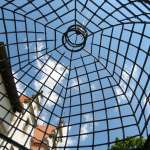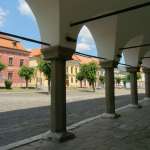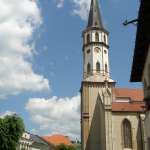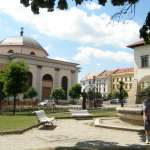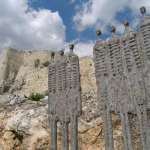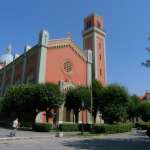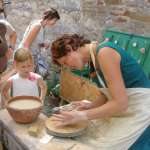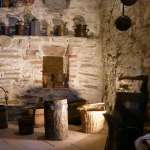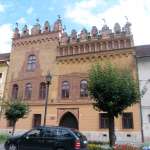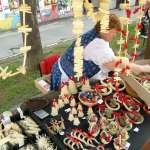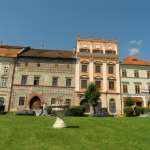
Počas nášho výletu Spišským okruhom postupne navštívime tieto zaujímavé miesta:
Spiš Castle
In the eastern horizon of Spišské Podhradie towers the Spiš Castle. As a National Cultural Monument, Spiš Castle with its area of more than four ha, and partially in ruins, is one of the largest castle compounds in Central Europe. Spiš Castle was included in the UNESCO World Heritage List in 1993.
Construction of the medieval castle on a travertine hill dates back to the beginning of the 12th century. The oldest written reference to the castle is from 1120. At the beginning it was a boundary fort placed at the northern frontier of an early feudal Old Hungarian state. Afterwards, it became the seat of the head of the Spiš region for many centuries.
In the second half of the 15th century the reconstruction of the castle fell upon its new owner Štefan Zápoľský whose intention was to remake it into a stately aristocratic residence. He had made a palace, a knight hall and chapel of St Elisabeth in the castle. His son Ján, later King of Hungary was born at the Castle.
The last building works at the Upper Castle were made under the orders of the Thurzos' and the Csákys'.
In 1780 the castle compound was destroyed by fire and the proud Spiš Castle gradually fell into ruins. The total decay of the castle was prevented only through the intervention of conservationists who in 1970 got down to the difficult job of preserving the walls and palaces threatened by the instability of its rocky base.
At present there are the collections of the Spišské múzeum placed in the castle documenting its history, along with medieval arms and feudal jurisdiction.
The landscape around the village of Spišské Podhradie can be seen comfortably by using the instructive footpath Sivá Brada – Dreveník, which has eight information boards along its route guiding the visitor through the travertine hills and natural phenomena in this part of the region.
Spišská Kapitula
The ecclesiastic town Spišská Kapitula is sometimes also referred to as the “Slovak Vatican”. Church life not only in Spišská Kapitula (The Chapter of Spiš) was organised from here by the bishops, provosts, and canonists. The town, along with other monuments around the Spiš Castle, is included in the UNESCO World Heritage List.
The most important building of Spišská Kapitula is the Late-Romanesque St Martins Cathedral. It acquired its massive form of a three-nave building with two towers in the years 1245 – 1275. In 1382, a Corpus Christi chapel was added to it, though it was replaced by the contemporary one in the years 1488 – 1493. This chapel of the Zápoľský family imitates the French chapel of Saint Chapelle. Baroque traits were erased by reconstruction in the years 1873 – 1889 in an attempt to give it a medieval character in line with the taste of the period of Romanticism.
The Bishop's Palace was built together with the Cathedral as a provosts palace. In the past, there used to be a French park around the palace and its entrance was next to the Hodinová veža (The Clock Tower) from 1739.
Levoča
The historic town Levoča, situated in the east of the Spiš region, is a true cultural and historic jewel among the Slovak towns as it possesses a great number of architectural monuments linked with the glorious past of the town.
The Town Monument Reserve of Levoča represents a complete set of important cultural and historical monuments bordered by the oblong, relatively well-preserved town walls.
The dominant part of the old Levoča is the large rectangular square, with the Roman-Catholic St. James church from the 14th century, which is one of the most important sacral buildings in Slovakia. The tall slender church tower from the first half of the 19th century is the most distinct feature in the city's silhouette.
Especially precious is the interior of the church, which is in fact a unique museum of medieval sacral art. The Late Gothic wooden main altar of St. James with the height of 18.6 m is the highest of its kind in the world. It was made of lime wood in 1507-1517 in the workshop of Maestro Pavol of Levoča. Maestro Pavol is said to have depicted himself as one of the statues of the twelve apostles in the exquisite composition of the Last Supper scene in the altar`s predella.
The church neighbours with the arcaded building of the former Town Hall which was built after the fire in 1550 and is one of the finest buildings of secular Renaissance architecture in Slovakia.
The so-called cage of opprobrium located in the square is from the 16th century and was used in the past as a pillory for the public humiliation. The central square is skirted by more than 50 remarkable burgher and patrician houses, many of which carry the name of their former owners. Of especial interest is Thurzo's house, which acquired its Neo-Renaissance sgraffito facade in 1904.
Kežmarok
The pride of Kežmarok is the Protestant wooden articled church. This Protestant church was built in 1717 next to an older sacral stone building from 1593, which today is a sacristy. This unique wooden building made of yew and red spruce wood was built without using a single metal component. The Baroque interior of the church is also made of wood. Of immense artistic value is also the church organ with wooden pipes.
Source: Vydavateľstvo DAJAMA
